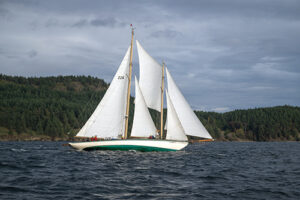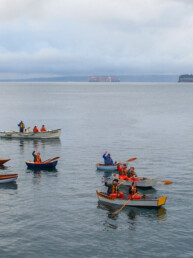With big breeze and tight racing, this year’s Round the County race was one for the books! Here’s the view from the iconic schooner, Martha.
Island after spit after peninsula fades away into the gray hues of a November morning. A breeze ripples the water, and gently rattles Martha’s halyards against her wooden masts. In the distance, the small shapes of sailboats speckle the depths of our vision. They sweep in from up and down Rosario Strait, rapidly filling the channel. In total, 119 boats of all makes and designs, and yet none that resemble Martha. She’s a schooner, and both the oldest and longest vessel on the course. We see our friend and rival Sir Isaac approaching in the distance; the only other schooner in the fleet.

This year, the Round the County Race that’s co-hosted by San Juan Island Sailing Club and Orcas Island Yacht Club is running in a counterclockwise direction, so it begins with a downwind start in the southerly wind, heading north to round Lawrence Point. Fingers of stronger pressure roll down prestart, prompting us to start with working sails flying. The main, jib, and stays’ls are raised rapidly by our crew of 12. I’m working the jib and forestays’l halyards. I’m a high school dinghy racer, which is a stark difference to racing on Martha. The fisherman and spinnaker are already lashed to the deck. Their sheets and halyards are led, and they’re ready to fly at a moment’s notice. The final long whistle finds us in the middle of the line, with racer cruisers and ULDBs obscuring both the boat and the pin. The call comes from the pit: “Raise the kite!” Jib comes down, and the asymmetrical spinnaker shoots up, flogging voraciously. In no time at all, we discover that the sheet was led through the lifelines, causing a few moments of panic while we transition the load to the speedily re-led lazy sheet.

The breeze is gusting well above 20, which suits Martha, but is wreaking its share of havoc for others — we see wipeouts and a couple of spinnakers blow up behind us. Seemingly minutes after the kite was up and pulling, we round Lawrence Point and trade the kite for the jib and fisherman. The rest of fleet has the option of holding the kite and sailing farther, or dropping it to follow the shore. There’s no question for us, as a reach is where Martha’s waterline and sail area truly pay off. The wind lightens up around here, with obvious holes where islands obstruct the southerly’s flow. We’re towards the front of the rapidly converging PHRF fleets, and slowly gaining. The TP52s roll us before we reach the Sisters, their kites temporarily blocking the sun as they walk by.
Soon, Patos Island light appears around the headland, a sign that our reaching leg has come to an end. Little by little, we have crept up, and are leading the PHRF fleet. The sleds racing under the ORC handicap are long gone, having rounded Patos before we came into view.
Martha surges gently through the slight chop as we sheet in and head on the wind. I go back to sweat in the main stays’l — a powerful sail with no winch — then work the downhaul to douse the fisherman. We take a long tack, heading out into Boundary Pass. With the breeze still on, we decide to throw a reef in the main, putting Martha in the groove. As we head farther south, the reality of racing a classic schooner sets in. While she sails fast, she points significantly lower than the modern vessels. Repeatedly, a nice covering position we have over our fellow competitors dissipates, as a leeward boat is able to pinch and sail right up from below us.
Many long tacks later and we’re laying Stuart Island’s Turn Point. It’s still shrouded by distance, almost indistinguishable from the islands in the backdrop. Sir Isaac has passed us on the upwind, along with much of the fleet. The crew holds onto the possibility of a reach after the point, but our close hauled port tack course makes that look improbable.
Turn Point doesn’t hold up to our hopes. We tack, set the fisherman, shake the reef, and continue on a close hauled course. Finally, barely before the finish line, we crack off a few degrees. Martha lights up, and is able to roll one boat before we cross the line. We take the fisherman down as we cross the line, and sail to our spot for the night in Roche Harbor.
Regular 48° North race writer, Stephanie Campbell, who spent Round the County racing with Paul Taylor’s Express 34, Wailana, had this to say about the first day and stopover at Roche: “For starters, I haven’t arrived that early in many years! The whole fleet filled the main guest dock by early afternoon. We got the sails folded and gear stowed just before the wind died and the rain started. The dock parties migrated to the big support boats and the race tents. We packed those tents like crazy! Free beer, live music, and steaming hot towels (if you were lucky and ran into Elise). “Ready for your rowdy” was not a typo in the skipper email after all. Also, evidently the people who arrived ahead of the rain squall weren’t interested in hugs from the rest of us. Eventually, we were hungry and tired, so we followed the island travel protocol and all 10 of us crammed into the back of a cargo van and off we went to the hotel for some well-earned shuteye! Thank you RTC volunteers — the festivities at Roche Harbor were as fun as ever and a good time was had by all.”
Sunday dawns cold and clear. We stow the dock lines, then meander out through sweeping Mosquito Pass. Lavish houses line the banks, with manicured lawns and fancy docks.
At this start, we can’t escape the challenges of sharing the compact starting area between San Juan Island’s Hanbury Point and Henry Island (where there are rocky shoals on the west side) with a huge fleet of 119 boats. Surprising some, it’s another downwind start. The line is blatantly boat favored, leading to a crowded and contentious start. We end up on starboard, just about in the middle, and a few seconds late. While on Saturday the pressure quickly dispersed the fleet, Sunday has much calmer winds. In the busy start, we are pushed out into Haro Strait with the fleet. We find ourselves unable to jibe closer to our ideal course but also not comfortable setting our spinnaker. A leeward boat tries to simultaneously head us up and set their spin, neither of which help them clear their air. We finally get room enough to jibe, and we set the spin once we’re comfortable on port tack. We’re heading south paralleling the western shore of San Juan Island, but still positioned outside of most of the fleet. Our kite goes up smoothly — we learned our lesson to double-check rigging the day before. The wind is dying, and we can see boats dousing their spinnakers ahead of us. A little more breeze fills in on the beach, making us regret not being more aggressive in our attempts to get closer to shore.

It’s not long until we have to transition to the jib. We douse going slightly hot and, just after the tack is blown, look up to see the head start to part from the rest of the kite. It is an old spinnaker, so not too surprising, but any sort of rip is always a very disappointing sight. We slowly get more powered up as the wind starts to veer. Before we’ve reached the Strait of Juan de Fuca, we’re close hauled, and taking long tacks up the shore. The part of the fleet who stayed along the shore gets their compensation and are able to short tack and stay in a little more pressure.
We continue our long tacks, again being reminded that upwind is a tough mode for Martha. There’s not much to do as the fleet slowly passes us. Looking for any improvement, we shake the reef, then decide we’re still overpowered and put it back in not even a minute later.
We make a few more tacks. The wind is diminishing, and we’re finally able to shake out the reef. By this time, most of the fleet is well ahead of us. We make a decision to switch to our gollywobbler; a sail that tacks to the foremast, and is flown instead of the fores’l and fisherman. Most of the fleet are just specks on the horizon, but we hold ground with two racer/cruisers and a lone trimaran.
Pressure in the distance prompts us to douse the gollywobbler just a few minutes after we set it. Finally, this pressure turns out to be real. It builds, and it builds fast. We douse the fisherman, as water pools at our feet and into our boots. It comes down, and we lash it to the deck and rush aft to put a deep reef in the main. Cattle Pass is just behind us, but Davidson Rock is still a ways ahead. There’s discussion of striking the jib, which is an alarming task when waves are breaking over the bow.
It’s just past 1:00 p.m. when the skipper calls it. We already have had a long day of upwind sailing, and we are sitting in dead last just trying to slog our way forwards. It is likely we could have finished, but it would have been past sunset. We fall off and reach through Cattle Pass. Our anchor grabs in Fish Creek, which is empty except for a few crab pots. The rain starts just as we finish flaking the jib, and we head below decks to the promise of a warm meal.

In a world of planing sportboats, Martha is a whole different beast. She can’t sail the same course as the sleds, yet she’ll rip on a reach. That advantage is null once she has to point upwind, which makes her sail a very different race, a race that can’t be described by ratings or numbers. The first day we corrected to second in our division, and 19th overall, right behind Sir Isaac. The second day, we retired deep into last place. All in all, it was a great weekend, with amazing competition across the board.
While we had a tough Sunday on Martha, around the fleet many will remember this as one of the best Round the County races ever. Tight racing, a lot of good wind, especially on Saturday, and mostly cooperative breeze directions meant short total elapsed times for many boats. Overall winners were the J/111 65 Red Roses among the two ORC classes, and the Swan 46 Setri across six PHRF divisions — each of whom also won their divisions. Other division winners were F45RC Cheekee Monkee, TP52 The Shadow II, J/120 Time Bandit, Wylie 42 Hana Mari, J/105 Creative took the J/105 one design division, our friends on the Burns 49 schooner Sir Isaac, and the Dufour 34 Invictus. Congratulations to all sailors!

Full results here.
Title background photo by Sean Trew.






